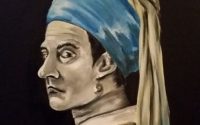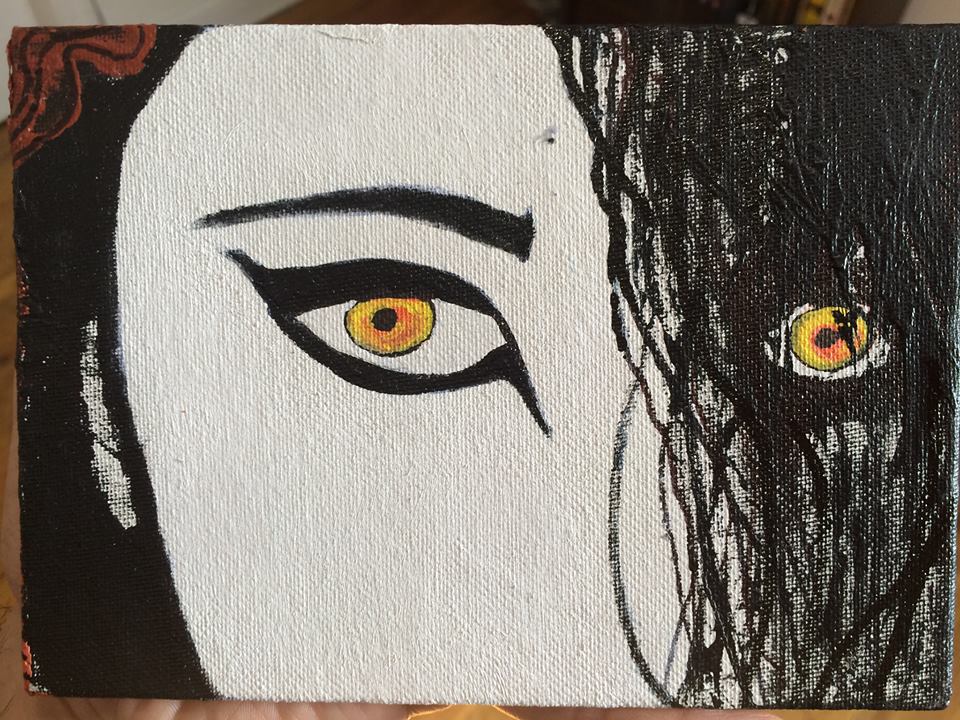Freaks, Punks and the Fragility of Community: Interview with Gretchen Hasse on her comic Freaks’ Progress
Gretchen Hasse is a storyteller working in comics, collage, public art, and moving images. She holds a BA in Anthropology from Northern Illinois University, and an MFA in Film, Video and New Media from the School of the Art Institute of Chicago.
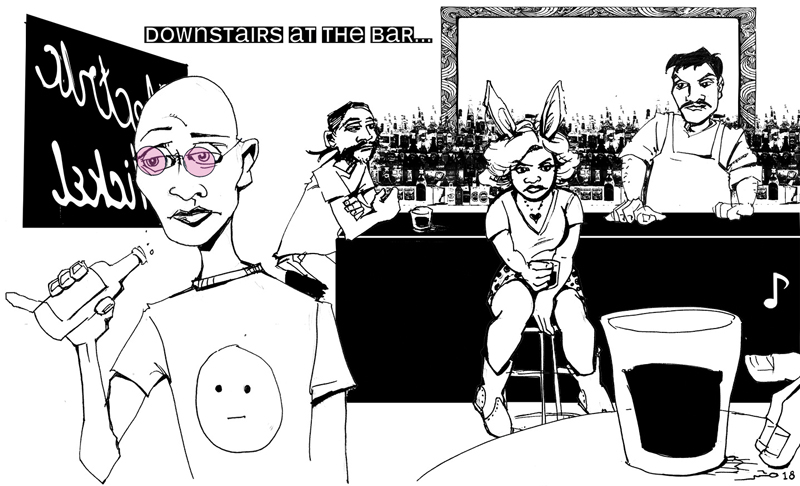 KILTER magazine: Gretchen, before we get into Freaks’ Progress, tell us a little about yourself as an artist.
KILTER magazine: Gretchen, before we get into Freaks’ Progress, tell us a little about yourself as an artist.
Gretchen Hasse: I’ve been an artist for as long as I can remember. I started writing, and then I taught myself to draw so I could illustrate the stories. Now, I do video, collage, public work and comics… different stuff. And all of my work still has a narrative.
KILTER: You’ve said narrative plays a key role in all your work, and your artist statement on your website says you see yourself as a storyteller, say a bit more about that.
GH: Yes. Though I don’t want to use that term “storyteller” lightly… as I try to explain what I do, I come back to the fact that story is behind it, and I’m always trying to explain things to myself in story. With the webcomic I’m working on now, I keep a lot of notes for plot development. The background for a lot of it is news or events that intrigue me, and I explore them through the stories. Like, the idea of self-acceptance I might explore through the characters of the conjoined twins in the comic. Or, the idea of entering middle age and accepting that you need to take care of the next generation – that is something I’m exploring with some of the characters in the comic.
KILTER: Yes, but these are human ideas and experiences… Is this your first comic?
GH: I’ve done comics but not that I’ve shared with anyone. For the longest time, I thought that none of it was good enough to publish. Also there were the time consuming facts of compiling and printing the comics. That’s another job description beyond the making of the comic itself; and I didn’t have the confidence or determination at the time to follow through. So now, the webcomic format is perfect for me, because I can keep up with twice a week posting, which works better for me than needing to have an entire story drawn and printed.
KILTER: Do you have favorite comic or comics or particular artists that inspire you?
GH: Love and Rockets, by the Hernandez brothers, to start. I’m sure many people will know them, but if you don’t you should look them up. The way they portray particularly female characters, is so accurate it’s almost embarrassing, because they really get it right. Also, I love the way they have characters age, with storylines that cover a large span of time. It’s really good writing.
I also love Joe Sacco. He studied journalism and worked as a journalist, and liked comics as well. What he has ended up doing, is comics journalism. He goes to war torn areas, like Gaza and Goražde, and interviews people. He includes himself as a character, and shows how he interacts with people he’s interviewing. Part of his point is to demonstrate how you can’t be truly objective. His drawing style is very complex and intense, which makes sense with the type of thing he’s covering. And he also has really good story telling skills, but his stories take place in the midst of conflict, and so they are never resolved.
Julie Doucet is another artist I admire. She does absurdest comics but also very self-portrait like, and they are very punk rock. A lot of her stories come from the point of view of a creative young woman who struggles with being taken seriously, and how her mistakes are taken differently than they would be taken if she were a man. I’m always looking for new artists and I’m looking for good writing. The art is important too, but personally I’m looking for long narrative arcs and character development over time.
KILTER: Tell us a little about Freaks’ Progress. Why this story, why now?
GH: It’s not necessarily the story, but the characters. Ever since I can remember I’ve always had some multi-character story running in my mind. In any phase of my life, different characters would be associated with that period. Honestly though, I think they’ve always been the same characters, but as I’ve gotten older I’ve started dealing with different issues, and so the characters manifest differently. There’s also always been a certain quest they’re all striving for.
This makes it challenging to say what the comic is about. People ask me “So what’s the comic about,” and I answer, “Everything!” Which isn’t much of an answer. But after some thought, I can say it’s about the fragility of real community. The place where the characters live is somewhat based on Chicago, where I’ve lived for 25 years. Behind the comic is my experience with various communities in Chicago, and seeing how those communities can so easily be disrupted, and how that is often devastating for the members of those communities.
All the characters in Freaks’ Progress have backstories that they bring to the narrative of the web comic. My overall goal is there’s the webcomic that is one main narrative arc, and then each of the characters has their own backstory, which I’m starting to explore through printed comics. The first one, which I’ve written and will soon start illustrating, is called Bar Bunny. Ideally, each of the characters will eventually have their own backstory printed comic. That will take a long while, but I am in no rush.
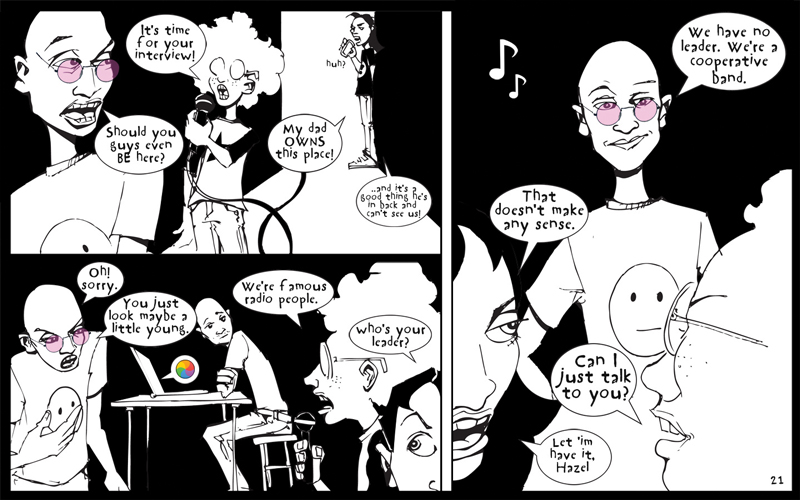 KILTER: Say a little more about the characters, without giving too much way, since Freaks’ Progress is character driven. Who will we encounter in Freaks’ Progress?
KILTER: Say a little more about the characters, without giving too much way, since Freaks’ Progress is character driven. Who will we encounter in Freaks’ Progress?
GH: The first chapter focuses on best friends Hazel and Lupita, two twelve-year-old girls. (The relationship is inspired by my friendship with that same friend Mary, who I drew comics with back in grade school.) Lupita is from Mexico, and Hazel is a blind girl with Irish and Cuban heritage. They are making a pirate radio station in Lupita’s room. She lives in the apartment above a bar, called the Electric Nickel, that Lupita’s father Jorge owns. The Electric Nickel is the de facto center of the neighborhood.
Lupita and Hazel are figuring out how to broadcast on the radio. It’s a retro thing – why would you have a radio station when you can just do a podcast? I like the idea of pirate radio; I like referring to different levels of technology existing at the same time. It is another way to express how different personal realities exist simultaneously. I had a friend who did pirate radio in various remote places. He told me that if you have a pirate radio station it’s easier to pick up with a car radio, and that worked its way into the plot. Later on in the chapter, we are introduced to these gangster characters in their car listening to the radio station of these twelve-year-old girls. (Laughter) Through that you also meet the stereotypical hipster character Preston with his laptop band, who is being interviewed by Lupita. So you get the layers and different types of characters.
In the second chapter you’re introduced to the middle aged men, which might be a little bit boring because it’s a lot of conversation in a bar. Rey is kind of scary. He owns a strip club that is a big employer in the neighborhood. And he owns properties, and he has PTSD from the war in Argentina. And Max, he’s a mystery; he’s just come to the neighborhood and always wears a biker jacket. I’m still introducing people. Introducing everyone is going to take several chapters.
KILTER: One of the things I notice and appreciate about your work in Freaks’ Progress is using unique and odd physical features to tell us about a person or character. Is that something intentional, are you aware of that focus?
GH: Yes, definitely. One of the things that is important to me is drawing out physicality in portraying characters. I do a lot of figure study work. Part of my interest in the human figure comes from the fact that I’ve dealt with a lot of physical pain in my own life. So bodies, physicality and problems with bodies has always been on my mind. I’m interested in how people express themselves physically, different body types and postures. I pay attention to how that expresses character, and what has happened to a person over their lifetime.
KILTER: Say a little about “Freaks” in the title, what does that means to you?
GH: The origin of the name is in the circus freak concept, which I know now is not the best place to begin. I started the idea of the story many years ago, when Max and the Twins were the main characters. In that original iteration, Max was a contortionist (he might still be, we’ll see), and he meets the Twins and they have a love affair. Over time I’ve brought in other characters, and kept the name. It’s definitely about claiming a term that was originally meant to be disparaging.
This is something I’ve talked about with my friend who’s a disability rights activist, and he says that the use of the word “freak” is tricky and I’m like ya, you’re right. And also the focus isn’t on Max or the Twins anymore. I have decided for now to keep the name, partly because I am seeing more and more people in the world who are boldly challenging what is perceived as “normal.”
“Freaks” makes me thinks of people who are perceived to be unusual, or unacceptable, or somehow not legitimate enough to be taken seriously in society. Claiming that term is a way to say no, actually it’s your idea of normal that’s weird, and frankly dangerous, because it limits and excludes so much of human experience, just to service a narrow idea of how society is supposed to function.
But also “freak” can mean a sudden change, like a “freak storm,” and that also seems to resonate with the story and the characters. “Freak” means something that is other than you would expect it to be, or not what it’s supposed to be. And that calls into question where we get our assumptions to begin with.
The “Progress” part of the title refers to those morality plays about a person falling to their ruin. I think William Hogarth did a series of prints along the same lines; Pilgrim’s Progress is maybe the first. Then, Rake’s Progress and then there’s A Harlot’s Progress too; all of them were about people falling to their ruin.
I don’t want anyone to fall to their ruin, but it will definitely take these characters a while to reach their bliss, or their purpose, which I want to be very meaningful if maybe not overtly heroic. The reference to these works is another instance of turning an old idea on its head; my story is not some moral judgment of people leading their lives “incorrectly.” It’s about how people make it with the circumstances they find themselves in.
KILTER: As we wrap up here, I can’t help but wonder if you might have some summation about Freaks’ Progress that maybe brings the elements of freaks as a positive self-identity, urban community and punk rock? What I’m getting at is that in my reading the comic has a certain cast or feel that unifies these different parts. Are you aware of some unifying element?
GH: Ya, I don’t know. There are things that as an artist you aren’t always aware of but it’s there. So, I’d be interested in what you are seeing. Do you think its iconic?
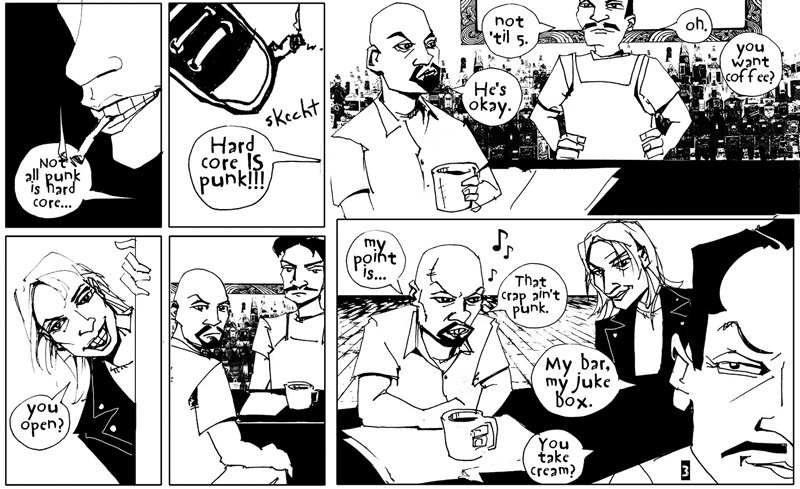 KILTER: I guess maybe a sense of “freakiness” to the comic, for me it’s something that’s intangible but there.
KILTER: I guess maybe a sense of “freakiness” to the comic, for me it’s something that’s intangible but there.
GH: Well it’s maybe fantastical and not like…I had this friend I roomed with for a while. We both came from rural small town settings, I from Idaho and he from Nebraska. We were both like, “we need to get to a city, we need to be surrounded by strangers.” So, there’s perhaps an element of that in the comic, that everything isn’t familiar or comfortable, there are people who aren’t like you. All the characters are meeting and interacting with people who are very different from the other characters and what they might know. They have to find a way to make that work. And honestly it ends up saving their lives, I think.
KILTER: In conclusion do you have a sense of the extent of this world or is it coming into existence?
GH: It’s both. I do have drafts of five chapters written. And I also have long term plot plans for each character. But as I rework the drafts things change and develop differently. The story also takes place in Portugal, Argentina, Mexico, and Hollywood. That’s all in the back stories of the characters.
– – – – – – – – – – – – – – – – – – – – – – – – – – – – – – – – – – – – – – – – – –
To find the webcomic, go to freaksprogress.com where it is published weekly.
Gretchen has three print comics related to the Freaks’ Progress available at the Armadillo’s Pillow Book shop in Rogers Park: The Big Stupid Pile of Love That No One Wants, An Afternoon at the Nickel, and Preston’s Lament.
You can also see Gretchen’s characters in Chicago murals at the Logan Square Dog Park, and on the CTA underpass at Pratt and Glenwood.
Future print comics will be made available on the Freaks’ Progress website. Bar Bunny is forthcoming.
